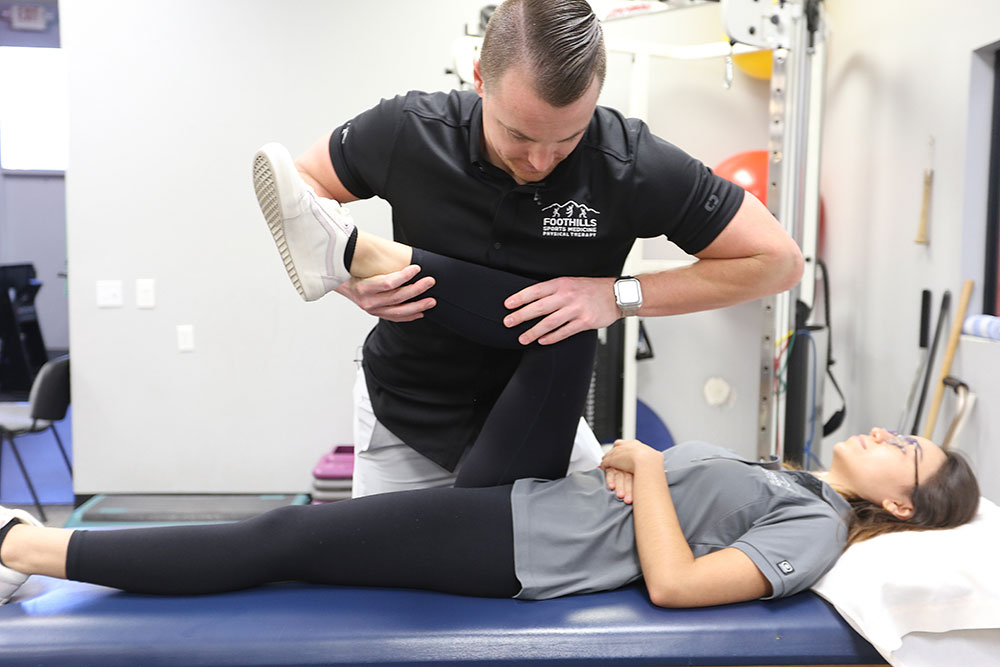If you experience hip pain, you are not alone. It is a very common complaint. The hip joint plays an important role in weight-bearing exercises, i.e., keeping your body upright and mobile. This puts tremendous pressure on the joint, which can result in pain. Hip pain can also result from an acute injury. To further complicate the matter, pain that appears to be coming from the hip may be referred. In other words, it may originate from another area of the body, such as the low back, and travel to the hip.
There are a number of physiotherapy hip special tests designed to determine whether the pain originates in the hip joint. The hip quadrant or hip scour test is one of these.
Is there a difference between a quadrant test and a scour test?
The hip quadrant test is a passive test that is used to assess if the hip joint is the source of a patient’s symptoms. A scour test is a different name for the same assessment, which is sometimes also referred to as the quadrant scour test. The difference between the scour test and the lumbar quadrant test is a completely different assessment used to diagnose pain in the low back.
The purpose of performing a hip scour test
The Hip Scour Test is a provocation test (special test) performed on the femoroacetabular joint (hip) to assess for nonspecific hip pathology. Being a passive test means that the physical therapist manually moves your joint through its range of motion without any effort on your part. The test is positive if the motion provokes your pain, which is why this type of assessment is called a provocation test.
Another reason to perform a quadrant test is to determine whether the hip can move through the full range of motion or is limited by pain. The test is considered positive if the range of motion is decreased, even without pain. Another positive result is crepitus from the joint, which is a crackling sensation that the therapist can hear or feel.
What conditions may provoke a positive hip quadrant test?
Structural deficits in the hip may result in a positive scour test. A positive hip quadrant test is indicative of an osteochondral lesion, early to late-stage osteoarthritis, capsular tightness or joint hypomobility, avascular necrosis, or even an acetabular labral tear, depending on the proximity of the tear to the compressed joint surfaces. In other words, problems with bones, cartilage, ligaments, and even blood vessels can cause damage to the hip joint that results in a positive scour test.
Hip scour test process
The therapist will ask you to lie flat on your back in the supine position, and “the affected limb is placed 90 degrees flexion and adduction and a compression force is applied and maintained through the femur through a range of 65-140 degrees of hip flexion,” Adam continues. “The test is repeated into varying ranges of abduction.”
In other words, the therapist will bend your knee, causing your hip to flex. He or she will put a hand on top of your knee, using it to apply pressure to compress the hip joint. Then the therapist will move your leg, with the knee still bent, inward toward your body. This brings your hip up off the examination table in a motion called adduction. Next, the therapist slowly moves your hip outward in a semicircular motion called abduction. At different points in the test, the therapist will ask you if you are experiencing any pain.

What happens after the scour test?
The next steps to be taken after the scour test depend on whether the results are positive or negative. The purpose of this test is to help guide your treating physical therapist by identifying the source of pain and individualizing the best possible manual therapy techniques and corrective exercises to eliminate your hip pain and restore your function. Therefore, if the test is positive, it helps your physical therapist devise a treatment plan for you.
If the test is negative, it suggests that your hip is not the source of your pain. This means that it is probably being referred to from somewhere else. In that instance, the next steps depend on the patient’s specific clinical presentation and subjective reporting.
Limitations of the scour test
While a scour test may rule out the hip joint as the source of your pain, it is not enough to confirm a diagnosis on its own. More testing is needed to determine the exact cause of the discomfort. It is best practice in physical therapy to combine multiple data points, including strength testing, ROM testing, palpation testing, assessment of functional movement patterns, and a combination of special tests (provocation tests) with high diagnostic accuracy. The therapist then synthesizes all findings to produce a data-driven plan of care.
If you’re experiencing hip pain and think you might need physiotherapy special hip tests, schedule a free injury consultation at one of our Arizona locations today.




